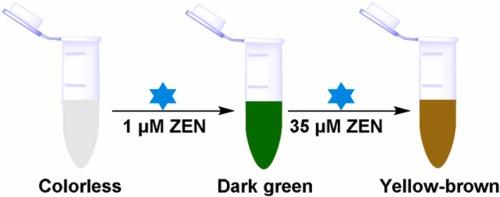利用基于无标记拆分普酶的双色光学传感器,直观、快速、高灵敏地检测玉米赤霉烯酮。
IF 8
1区 化学
Q1 CHEMISTRY, ANALYTICAL
引用次数: 0
摘要
鉴于玉米赤霉烯酮(ZEN)对人类健康和安全的重大风险,本研究开发了一种双色光学传感器,称为分体式肽酶。所构建的分体式蛋白酶采用与玉米赤霉烯酮结合的分体式吻合器作为高目标识别元件,并采用分体式 G-四链DNA酶作为高效的信号报告元件。在没有 ZEN 的情况下,分裂链 接酶的两个片段保持分离,溶液呈无色。但在微量 ZEN 存在的情况下,这两个片段会立即组装成一个复合物,该复合物可以将 2,2′-氮基-双(3-乙基苯并噻唑啉-6-磺酸)(ABTS)氧化成彩色 ABTS-+(深绿色)。更重要的是,由于过量的 ZEN 和 ABTS-+ 发生了新的反应,溶液的颜色会随着 ZEN 浓度的进一步增加而变成黄褐色。与其他测试毒素相比,这种方法对 ZEN 具有很高的选择性,可测量的检测限值很低,仅为 6 nM。值得注意的是,分体式合酶成功地应用于实际样品(小米、燕麦、薏苡仁和苦杏仁)中 ZEN 的定量检测,并实现了低至 1 μM 浓度的 ZEN 裸眼检测。鉴于基于裂解质粒酶的 ZEN 检测方法易于使用、无需标记、无需设备、快速且具有高规格性和灵敏度,这种开发的传感策略可通过替换相应的质粒酶序列随时用于其他毒素的现场肉眼检测。本文章由计算机程序翻译,如有差异,请以英文原文为准。

Visual, fast and highly sensitive detection of zearalenone by two-color optical sensor based on label-free split aptazyme
Concerning significant risks of zearalenone (ZEN) to human health and safety, a two-color optical sensor, termed as split aptazyme, was developed in this work. The constructed split aptazyme employed ZEN-binding split aptamer as highly target-recognized element and split G-quadruplex DNAzyme as efficient signal reporter. In the absence of ZEN, the two fragments of split aptazyme remained separate and the solution showed colorless. But in the presence of trace ZEN, these two segments would immediately assemble to form a complex that could perform oxidation of 2,2′-azino-bis (3-ethylbenzthiazoline-6-sulfonic acid) (ABTS) to colored ABTS•+ (dark green). More importantly, the solution color would change into yellowish-brown upon further increasing the concentration of ZEN, owing to a new reaction happening between excess ZEN and ABTS•+. This approach showed high selectivity towards ZEN over other tested toxins with a low measurable detection limit value of 6 nM. Notably, the split aptazyme was successfully applied for the quantitative detection of ZEN in real samples (millet, oat, coix seed, and bitter almond) and enabled naked-eye detection of ZEN at concentrations as low as 1 μM. Given that split aptazyme-based assay for ZEN determination was easy-to-use, label-free, equipment-free and rapid with high specificity and sensitivity, this developed sensing strategy would be readily applicable for on-site visual detection for other toxins via replacing the corresponding aptamer sequences.
求助全文
通过发布文献求助,成功后即可免费获取论文全文。
去求助
来源期刊

Sensors and Actuators B: Chemical
工程技术-电化学
CiteScore
14.60
自引率
11.90%
发文量
1776
审稿时长
3.2 months
期刊介绍:
Sensors & Actuators, B: Chemical is an international journal focused on the research and development of chemical transducers. It covers chemical sensors and biosensors, chemical actuators, and analytical microsystems. The journal is interdisciplinary, aiming to publish original works showcasing substantial advancements beyond the current state of the art in these fields, with practical applicability to solving meaningful analytical problems. Review articles are accepted by invitation from an Editor of the journal.
 求助内容:
求助内容: 应助结果提醒方式:
应助结果提醒方式:


